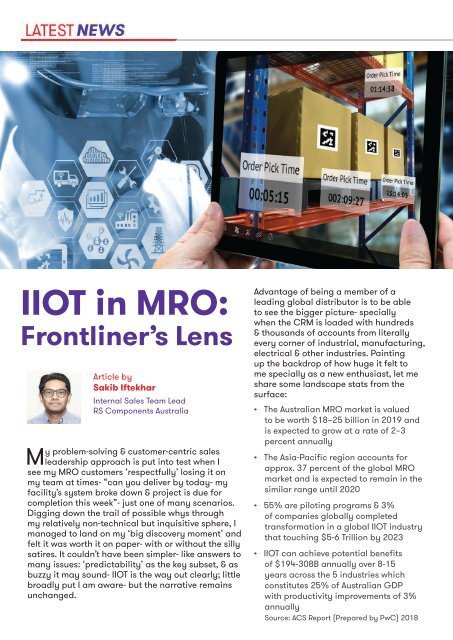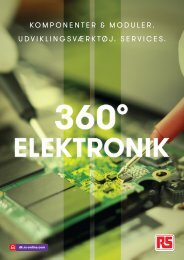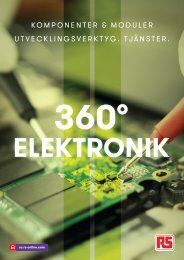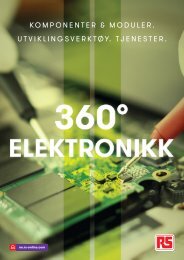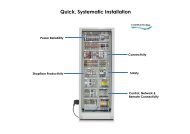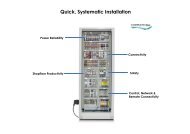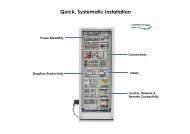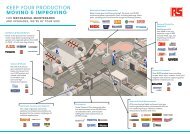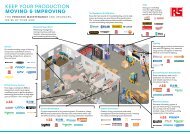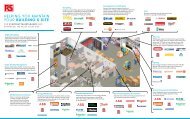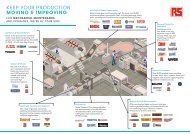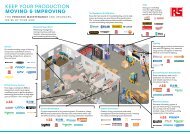MRO Solutions - November Edition
You also want an ePaper? Increase the reach of your titles
YUMPU automatically turns print PDFs into web optimized ePapers that Google loves.
IIOT in <strong>MRO</strong>:<br />
Frontliner’s Lens<br />
Article by<br />
Sakib Iftekhar<br />
Internal Sales Team Lead<br />
RS Components Australia<br />
My problem-solving & customer-centric sales<br />
leadership approach is put into test when I<br />
see my <strong>MRO</strong> customers ‘respectfully’ losing it on<br />
my team at times- “can you deliver by today- my<br />
facility’s system broke down & project is due for<br />
completion this week”- just one of many scenarios.<br />
Digging down the trail of possible whys through<br />
my relatively non-technical but inquisitive sphere, I<br />
managed to land on my ‘big discovery moment’ and<br />
felt it was worth it on paper- with or without the silly<br />
satires. It couldn’t have been simpler- like answers to<br />
many issues: ‘predictability’ as the key subset, & as<br />
buzzy it may sound- IIOT is the way out clearly; little<br />
broadly put I am aware- but the narrative remains<br />
unchanged.<br />
Advantage of being a member of a<br />
leading global distributor is to be able<br />
to see the bigger picture- specially<br />
when the CRM is loaded with hundreds<br />
& thousands of accounts from literally<br />
every corner of industrial, manufacturing,<br />
electrical & other industries. Painting<br />
up the backdrop of how huge it felt to<br />
me specially as a new enthusiast, let me<br />
share some landscape stats from the<br />
surface:<br />
• The Australian <strong>MRO</strong> market is valued<br />
to be worth $18–25 billion in 2019 and<br />
is expected to grow at a rate of 2–3<br />
percent annually<br />
• The Asia-Pacific region accounts for<br />
approx. 37 percent of the global <strong>MRO</strong><br />
market and is expected to remain in the<br />
similar range until 2020<br />
• 55% are piloting programs & 3%<br />
of companies globally completed<br />
transformation in a global IIOT industry<br />
that touching $5-6 Trillion by 2023<br />
• IIOT can achieve potential benefits<br />
of $194-308B annually over 8-15<br />
years across the 5 industries which<br />
constitutes 25% of Australian GDP<br />
with productivity improvements of 3%<br />
annually<br />
Source: ACS Report (Prepared by PwC) 2018<br />
What apparently made more sense to me<br />
connecting few dots is the data from The World<br />
Economic Forum’s (WEF) Readiness for the<br />
Future of Production Report 2018 which does<br />
not include Australia among the 25 ‘Leading<br />
countries’ that have both a strong existing<br />
production base and exhibit a high level of<br />
readiness for the future. Australia is, however,<br />
named in the report as being among several<br />
‘High Potential countries’ strong enough to<br />
impact the APAC picture for good.<br />
The report states that Australia is in a strong<br />
position to potentially improve its production<br />
base in future and cites signed I4.0 agreement<br />
with Germany and the Australian Government’s<br />
forward-thinking strategies as positive<br />
signs. While high-volume manufacturing<br />
is increasingly becoming the domain of<br />
countries such as China, the US and Japan,<br />
the opportunity highlighted for Australian<br />
companies is in focussing on low volume, but<br />
highly customised products delivered using<br />
advanced manufacturing techniques. The bold<br />
lines that felt intriguing on the article was “this<br />
high quality, smart and agile manufacturing is<br />
where Australia’s highest potential lies.”<br />
‘PREDICT’ AS KEY<br />
As one of the key outcomes of IIOT in <strong>MRO</strong>,<br />
what predictive maintenance does is<br />
eliminate manual intervention & achieve<br />
greater operational efficiency. IIOT enabled<br />
machineries within ‘smart factories’ predict<br />
potential breakdowns & failures in advance &<br />
carry out:<br />
• Accurate Demand Prediction<br />
• Automated Procurement<br />
• Automated Production<br />
• Automated Repair & Maintenance Systems<br />
The above, if deployed & leveraged fully, can<br />
be ground-breaking specially when costsavings<br />
is sitting as the top agenda in the<br />
executive board meetings. Being said that, the<br />
list of challenges within <strong>MRO</strong> are long too; but<br />
unlike a great movie with a strong antagonist<br />
fighting the hero, it seems ‘cons’ are weaker<br />
here & less scary than the ‘pros’.<br />
What makes <strong>MRO</strong> challenging as a category<br />
itself are 2-folds:<br />
• High volume of multiple SKUs within inventory<br />
management<br />
• <strong>MRO</strong> materials & service requirements are<br />
fragmented across operational floors and<br />
different machinery types- making demand<br />
tracking, forecasting a cumbersome process<br />
Now, incorporating some information<br />
from a report by RMIT University (2020)<br />
here, the biggest barriers internally within<br />
Australian SME context are: acquiring the<br />
data, integrating systems, data visualization<br />
& extracting value from the data. Other<br />
barriers surfaced were I4.0 savvy-workforce,<br />
understanding of I4.0, data security concerns<br />
& lack of trusted supplier partners who<br />
understands & facilitates end-to-end transition<br />
& deployments.<br />
This last bit clearly overlaps with both key<br />
prerequisites & impacts of IIOT itself, i.e., the<br />
evolving of & partnership with business models<br />
& companies offering ‘<strong>MRO</strong>-as-a-service’<br />
- managing all <strong>MRO</strong> procurement activity<br />
including system integrators to develop the<br />
IIOT systems - ‘one-stop-place’ simply put.<br />
Companies who specialised in IIOT solutions &<br />
have invested in it found that benefits outweigh<br />
the cost by huge margins. A survey by world<br />
industrial automation (2016-17) on companies<br />
who invested in IIOT clearly depicted improved<br />
operational efficiency by 47% and downtime<br />
reduction by mammoth 28%. Now, surpassing<br />
all others but with only through my frontliner’s<br />
viewfinder, the possible dents of IIOT are:<br />
• Improved customer information,<br />
communication, tracking and reporting,<br />
• Predictive and pre-emptive customer service<br />
and market development practices<br />
• Capacity for sharing real-time order status<br />
updates with customers.<br />
• Greater agility to react quickly and precisely<br />
to dynamic market requirements<br />
In context of current Covid19 which has<br />
enabled digital transformation as a speed<br />
never imagined before- now is the<br />
time I believe. It has brought to light<br />
the promises of IIOT to connect the<br />
physical & digital world along with<br />
super-delicious food-for-thought for<br />
industries & government to leverage<br />
those opportunities for economic<br />
growth & social benefit.


